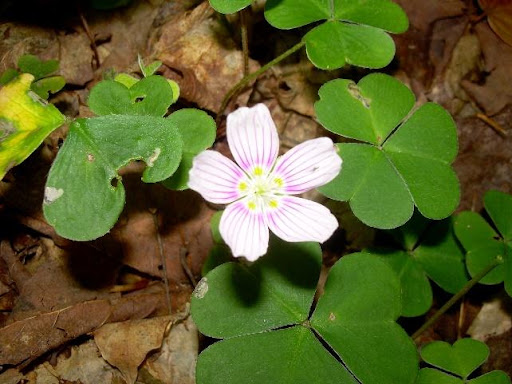Looking for luck: Four-leaf clovers and shamrock
By Chris Firestone
We all can use a little luck, and sometimes plants come to the rescue. It’s lucky to find four-leaf clovers, a rarity of the typical three-part leaf of white clover, Trifolium repens. This common non-native species is naturalized and planted in lawns and wildlife food plots.
My sister, the four-leaf clover finding champion, comes up with a handful of four-leaf clovers in a matter of seconds. According to clover geneticists at UGA, an inherited recessive gene is expressed during warmer periods, often producing many in a patch. Four-leaf clover folklore dates back to the Celts who believed a four-leaf clover provided magical charm and protection from bad luck.

Two native clovers one would be lucky to find in Pennsylvania are Trifolium stoloniferum, running buffalo clover, and Trifolium virginicum, Kate’s mountain clover. Both are recent finds and listed as endangered. Running buffalo clover inhabits dry, upland forests and Kate’s mountain clover prefers shale barrens.
Photo: Running buffalo clover

The shamrock associated with St. Patrick’s Day is another lucky plant. Coming from the Irish word seamair, meaning “young clover”, a shamrock looks like clover, with three-part (trifoliate) leaves. The history and biology of a shamrock is fascinating. St. Patrick used the three-part shamrock as a symbol of the holy Christian trinity.
Botanically speaking, there is no plant solely identified as a shamrock in Ireland and generally includes clovers and plants in the Oxalis genus.
Pennsylvania has five native species of Oxalis that grow in various habitats such as dry and moist hardwood forests, lawns, and gardens. The leaves are three parted and look like shamrocks. Wood sorrel or wood shamrock (Oxalis montana) is frequently found in Pennsylvania forests. This species is not as rare as the native clovers but consider yourself lucky to find it because this means you are simply outside enjoying Penn’s Woods!
Photo: Wood shamrock

Yellow wood sorrel (Oxalis stricta) is very common, almost weedy in PA gardens. Nevertheless, consider yourself lucky because you just found a weed you can eat while playing in the dirt.
Photo: Yellow sorrel

If you can’t wait to find your lucky plants outside this St. Patrick’s Day, you can resort to buying your lucky shamrock at a store, likely one of the hundreds of different species found worldwide.
Photo: A potted plant in the genus Oxalis, sold as shamrock at local store

“May good luck be with you wherever you go, and your blessings outnumber the shamrocks that grow” – Irish Blessing
About the Author: Chris Firestone
Chris Firestone is a botanist with 27 years in the Bureau of Forestry, working to conserve native wild plants in Pennsylvania through policy, education, and management of habitat and invasive species. She lives in Potter County and enjoys gardening, foraging, hiking and camping.



